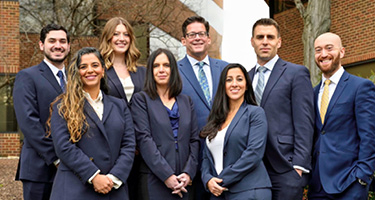As the principal of Connick Law LLC in Ohio, Thomas J. Connick has represented clients from all walks of life. Whether claims originate from a physical injury or because of bad faith—like incurring excessive fees—he often sees their broader potential as class actions. Going bigger might take more time, but Connick’s results demonstrate how a class action can be more rewarding by securing a financial and legal impact that is felt locally, nationally and in an industry.
Connick is recognized in the 2022 edition of The Best Lawyers in America® for Construction—Litigation and has received numerous accolades from the media and the legal community. But his experience has transcended several practice areas and some of his greatest successes are securing settlements in class actions.
Throughout his career of more than 20 years, Connick has uncovered patterns of injustice, held corporations and well-funded defendants accountable and helped make clients whole again through class actions—many of which stemmed from a single claim. To learn how he identifies legal opportunities to maximize a client’s recovery, Best Lawyers recently sat down with Thomas J. Connick.

Throughout his career of more than 20 years, Connick has uncovered patterns of injustice, held corporations and well-funded defendants accountable and helped make clients whole again through class actions—many of which stemmed from a single claim. To learn how he identifies legal opportunities to maximize a client’s recovery, Best Lawyers recently sat down with Thomas J. Connick.
How broad is the spectrum of the consumer class actions you handle?
Consumer class actions begin with people who have been wronged—and possibly injured—when the provider of a good or a service has not honored or carried out their responsibilities correctly. The consumers are the regular folks who unknowingly bought or rented cars, insurance plans or medical devices, for example, which were defective, harmful or not up to their advertised standards. Sometimes the harm is financial, physical or psychological, and oftentimes it is a combination.
How do class actions come across your desk?
A class action usually begins as an individual claim, followed by one of two typical scenarios.
The first way harkens back to a case I settled against a national rental car company. The first client called and said they were charged several excessive fees on their rental bills. We initially approached the case as a breach of contract and bad faith litigation. The fact was that the fees were neither ethical nor legal, but the client raised a great point and said, ‘I seriously doubt this is only happening to me.’ So we investigated it further and found several other people with the same experience, which led to a larger class action.
The other way comes up in conversation a bit more subtly. I knew someone who bought a new car who complained that it would stall if he turned the wheel a certain way. New cars should not have that issue, so I did a little investigating on my own—and sure enough, found other owners of the same car with that problem. I felt confident about the potential of the case—primarily because I felt we could prove this was a major traffic hazard that needed correction in order to keep people safe. But I also received permission from the first claimant to designate them as the class representative in the class action, because these matters take a long time and there’s no way you can consistently coordinate with dozens or hundreds of plaintiffs at once.
Is it safe to assume that your determinations on what would make for a class action are not made overnight?
It takes weeks, often months, at least, and I take it very seriously. It’s like a science. My firm performs intensive due diligence before mentioning the potential for a class action, because it is a high-stakes matter and we want to be fully prepared. Our staff begins researching, and I collaborate with outside experts who worked in the industry as well as economists and financial guides.
We do this to protect ourselves as well to ensure we have the financial capacity and manpower to handle a class action.
And once you proceed and file the motion for a class action, how long could the process take?
The entire case could be anywhere from two to five years, which includes at least one year of discovery. If we partner with other firms, which is common when filing class action motions, that increases our chances for a favorable resolution, but it could also increase the timeline.
There are deadlines for other claimants to join the class as well. After we file the class, we are permitted to reach other consumers through the defendant’s records. This occurs during early stages of discovery—that’s when consumers receive those emails or mail cards that ask about a product that they purchased years earlier. Much of it stems from registering products and buying warrantees, which protects you in more ways than one.
The COVID-19 pandemic has slowed down the process from what it had been, as well. That’s why we make sure that the plaintiffs—and especially the class representatives—genuinely want or need to file their claims to seek justice, inspire change and also recover financially.
Does a class action need to end with a verdict to achieve those goals?
No. In fact, most class actions do not go to trial and verdicts are extremely difficult to achieve, and therefore much rarer than settlements. Even though a defendant does not necessarily admit guilt or fault by way of a settlement, there is often a substantial monetary reward, and they often use the experience as a milestone to end the negligent or malicious practice that caused the litigation in the first place.
Are the award amounts greater in a class action as opposed to a single claim?
The gross amount is often far greater than that of a single claim. Class actions can be higher risk, which is why they yield higher rewards. This can even translate into the individual awards once a resolution is reached.
How are class action claimants compensated following their settlement?
The courts decide the amount of the awards. The starting point is based on the number of plaintiffs and lawyers, but each case has a different structure and considers the variety of potential damages we mentioned earlier and that also impacts how the awards are allocated.
Attorneys are compensated as well because these cases are very expensive to litigate. Lawyers are responsible for the court filing fees, for example, and the court determines the amounts that are reasonable, fair and adequate.
But in my experience, at least 90% of the people who participate in class actions are not in it for the money. The real bottom line, for them, is to break harmful patterns and prevent other people and their children and families from also becoming victims. That’s why class action litigation is truly one of the best ways in our justice system to stop any wide-scale risk or issue. It can even influence how states and the federal government draft legislation, in an effort to further protect the public.
It sounds like this is a gratifying area of practice for you.
Definitely. I get to know my clients intimately because I work for them for years at a time, and it often involves their families and their private lives. We develop bonds that are very unique and often stay in touch years after a resolution has been reached, which in many respects are my greatest achievements.
Harkening back to what we discussed about how cases make their way to my desk—those initial claims often originate as referrals from past clients. Having insight into the process, former clients send their friends and families to me, which is the highest honor. Their faith in me continually strengthens my own belief in our justice system.
Any claimant or consumer who has been a victim of bad faith or physical injury due to a product or service should speak with a lawyer with experience in the highly-focused area of class action law.
Learn more about Connick Law LLC’s tradition of success and excellence at www.ConnickLawLLC.com and (216) 364-0512.































